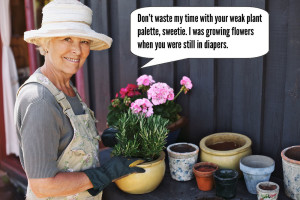A lot of landscapers only know a handful of plants, and you can see it in their jobs. “Wow, you used those six plants AGAIN, Danny?” Don’t be that guy. Cookie cutter landscapes suck.

When I moved from Arizona to Virginia in 2005 and started my new job as THE landscape designer for an awesome landscape design-build firm, I had a problem. It had been almost a decade since I’d done landscape design on the East Coast. Sago palms and barrel cacti weren’t going to fly here. To keep my job I had to get up to speed, quick.
I was the only white guy on a crew of Mexican workers when I took my first job in California. When you’re the big goony gringo (my nickname was “el Gigante”) you really need to learn the language fast, because you need to know what joke you’re the butt of. I was working 45 minutes from home and managing an apartment building as well, so time was limited. I resolved to spend 20 minutes a day, every day, learning Spanish. I made flash cards for a handful of words and every day I’d drill them, over and over. I never got fluent, but I was conversant.
As a result I knew exactly how I’d learn plants: flash cards. I thought about what aspects of the plants I’d need to know to use them effectively in a design. Here’s what I drilled:
- Common name
- Botanical name
- Tree, shrub, perennial, or annual
- Evergreen or no
- Bloom color and time
- Size at maturity
- One cool fact
Why one cool fact? Because your average non-gardening homeowner is never going to remember this blur of greenery, but she’ll remember that the oldest yew in the world is in Ireland and is over 3,000 years old. It gets them excited, and an excited homeowner becomes and excited customer. If we create the perfect design that will rock someone’s world but we can’t help them understand that it’s worth doing, we fail. It’s that simple.
Anyhow, that’s what worked for me and it can work for you. Do you have something else that works for you? Let’s hear it in the comments!